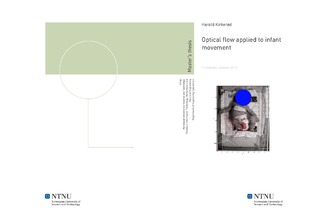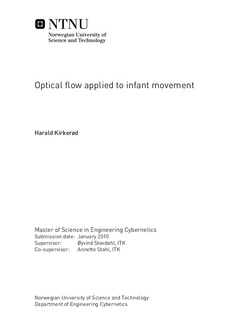| dc.contributor.advisor | Stavdahl, Øyvind | nb_NO |
| dc.contributor.advisor | Stahl, Annette | nb_NO |
| dc.contributor.author | Kirkerød, Harald | nb_NO |
| dc.date.accessioned | 2014-12-19T14:02:23Z | |
| dc.date.available | 2014-12-19T14:02:23Z | |
| dc.date.created | 2010-09-04 | nb_NO |
| dc.date.issued | 2010 | nb_NO |
| dc.identifier | 348932 | nb_NO |
| dc.identifier | ntnudaim:5294 | nb_NO |
| dc.identifier.uri | http://hdl.handle.net/11250/259942 | |
| dc.description.abstract | Healthy infants in the age group of 9 to 20 weeks post term have a distinct movement pattern called fidgety movements. The abscense of, or anomalies in these movements are indications that the infant may suffer from Cerebral Palsy. Data from video clips of infants have been extracted and used as features for classifying these movements as normal or abnormal. An earlier project used the concept of motiongrams for extracting the centroid of motion and quantity of motion of the image from each frame of the video clips. This project attempts to improve the dataset by extracting the same features using the concept of optical flow. Using the classification methods that yielded the best results from the motiongram project, the new dataset based on optical flow was constructed and tested for comparison. The image was as before divided into four quadrants with a circle of varying radius in the middle. Tracking how the centroid of motion moved between the separated areas of the image generated a transition probability matrix. By classifying on the entropy and variance of this matrix, a sensitivity of 90,0% and a specificity of 94,6% was reached, which was an improvement compared to the best classification result based on motiongrams with a sensitivity of 90,0% and specificity of 86,6%. The overall performance of both methods are around a sensitivity of 90% and a specificity of 70%. Using motiongrams and optical flow to extract features from video data for classification has turned out to be a promising approach for a simple and non-invasive objective tool for diagnosing infants with Celebral Palsy. The movement information in an optical flow field does however have a much higher potential for generating discriminative features than just as the simple representation a centroid of motion actually is. | nb_NO |
| dc.language | eng | nb_NO |
| dc.publisher | Institutt for teknisk kybernetikk | nb_NO |
| dc.subject | ntnudaim | no_NO |
| dc.subject | SIE3 teknisk kybernetikk | no_NO |
| dc.subject | Medisinsk kybernetikk | no_NO |
| dc.title | Optical flow applied to infant movement | nb_NO |
| dc.type | Master thesis | nb_NO |
| dc.source.pagenumber | 58 | nb_NO |
| dc.contributor.department | Norges teknisk-naturvitenskapelige universitet, Fakultet for informasjonsteknologi, matematikk og elektroteknikk, Institutt for teknisk kybernetikk | nb_NO |

